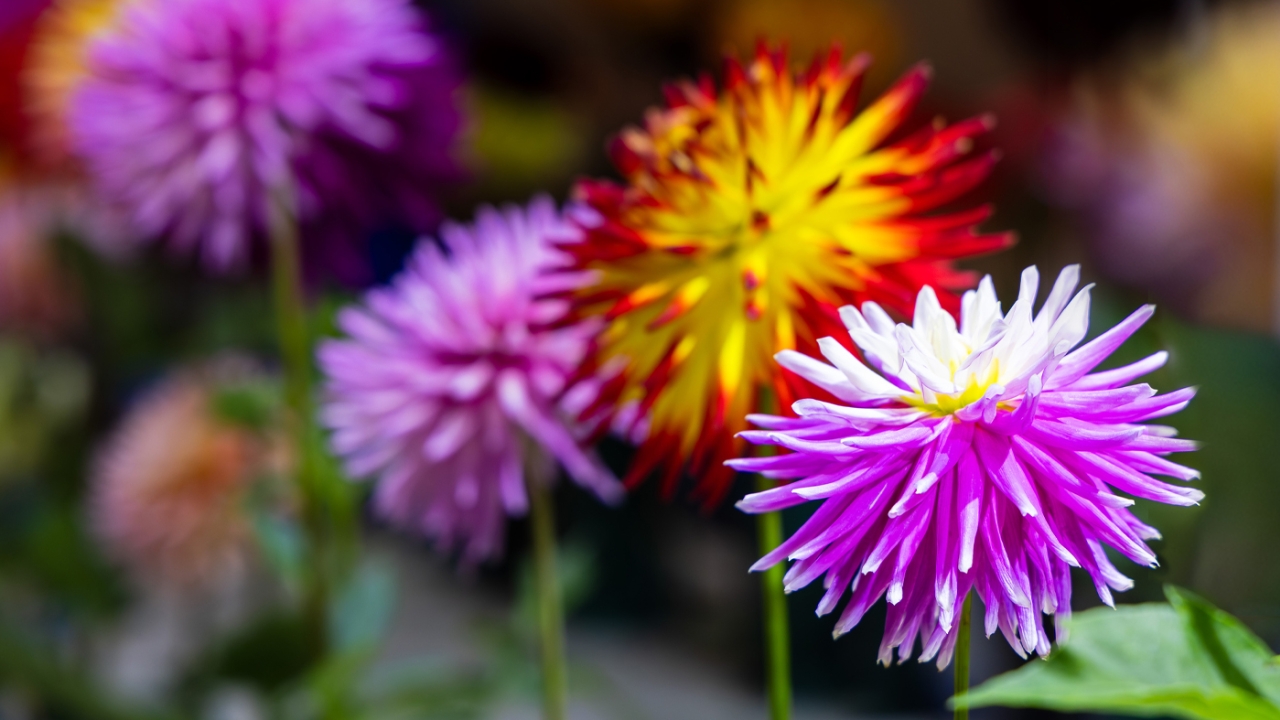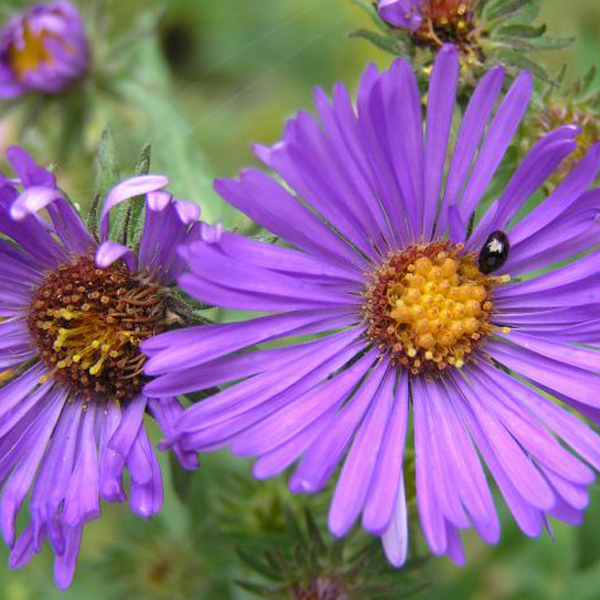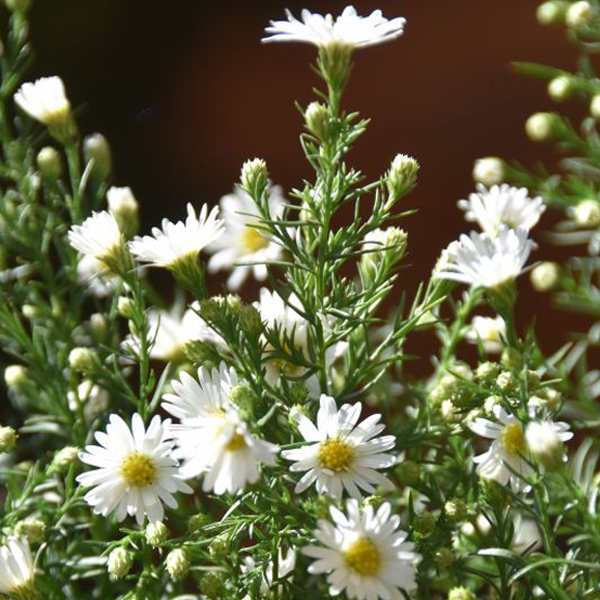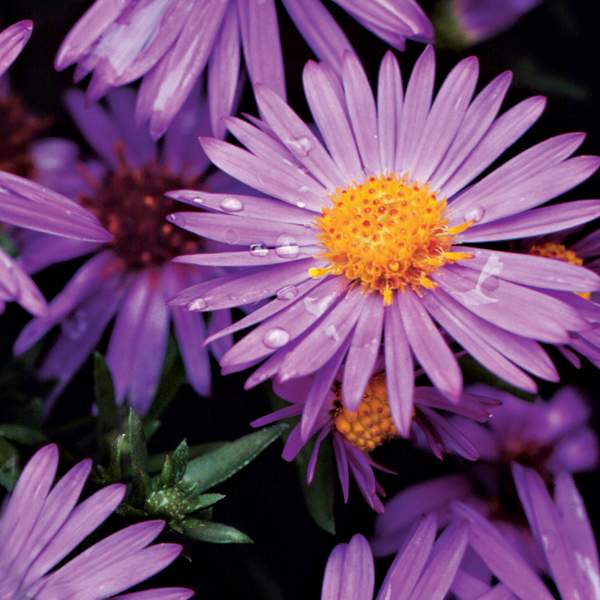

Smart Gardener
Native Asters Shine in the Garden
Blue and yellow, goldenrods and asters — classic colors of an Illinois autumn. Asters are easy to grow, if you plant them in full sun, in soil that is well-drained but not too rich, and you don't overdo water or fertilizer. But which asters?
Richard Hawke, manager of plant evaluation at the Garden, has already evaluated goldenrods. Now he is finishing up a massive trial of asters (or plants known as asters) – beginning with 180 different plants. He was happy to share the scoop before he finishes the official report on their garden-worthiness, which will appear soon among the Garden's other evaluations.

A bee alights on New England aster (Symphyotrichum novae-angliae).

This Monte Cassino aster ( Symphyotrichum pilosum var. pringlei 'Monte Cassino' ) blooms in white.

While beautiful in the annual bed, this New York aster (Symphyotrichum nova-belgii 'Henry III') is not well suited to survive Chicago's winters.
But first, the scoop on names.
Most of the plants we commonly call "asters" are no longer officially asters. DNA testing has allowed botanists to establish the genetic relationships of plants much more accurately, and that has led to smaller classifications and many recent name changes. For example, the majority of native North American species formerly classified as asters are now in the genus Symphyotrichum.
Botanists have made the switch, but since many nurseries, garden centers, catalog companies, and even garden writers have yet to get on board with the new names, I'll give both, as well as the common names.
In Hawke's trial, the clear winners among fall bloomers were several American native species. These are not necessarily the ones an ecologist would choose for a prairie restoration, but those likely to do best in a garden. And they were not necessarily the species and cultivars most often recommended for gardens.
Hawke's go-to plant was aromatic aster (Symphyotrichum oblongifolium, formerly Aster oblongifolius). With sky-blue flowers on stiff 1- to 3-foot stems, it flowers prolifically into October or even November if frost comes late, and can be seen in the Lakeside Gardens in September and October. Over several years in the trial, it was reliably hardy and the best overall garden performer. Two cultivars are available: 'October Skies', which is somewhat bushier and grows to about 18 inches high, and 'Raydon's Favorite', with medium blue flowers.
Aromatic aster did better than the species widely recommended in garden books, the 3- to 4-foot-tall New England aster (Symphyotrichum novae-angliae, formerly Aster novae-angliae).
New England asters can be seen in fall in many parts of the Garden. In the trial, they got more powdery mildew than aromatic aster and their habit was "more rank," Hawke says. Cultivars such as 'Purple Dome' often had browned-out leaves and bare lower stalks.
Native plant lovers may be struck by this finding, since New England aster, in the wild, was much more widely distributed in the Chicago region than aromatic aster, a rather rare species largely confined to dry limestone outcroppings. But Hawke's program tests plants for their garden-worthiness, under the conditions to which gardeners tend to subject plants. And for Chicago-area gardens, he says, New England aster is just so-so.
The great virtue of New England aster and its cultivars is the greater range of colors, from purple through pink to white. Aromatic aster blooms only sky blue. But Jim Ault, head of the plant breeding program at the garden, is now experimenting with making selections or hybrids to create cultivars of aromatic aster that bloom in pink or other colors.
One aster not worth bothering with, Hawke says, is Michaelmas daisy or New York aster (Symphyotrichum novi-belgii, formerly Aster novi-belgii). This species is native to the Atlantic coast. Most of the specimens in the Garden's trial died in their first Chicago winter.
Another Chicago-area native, calico aster or side-flowering aster (Symphyotrichum lateriflorum, formerly Aster lateriflorus), did well. It stands up to 4 feet tall with broad clusters of pale-pink to lavender flowers with deep pink centers. "That was really good," Hawke says, "but the rabbits really got to it." 'Lady in Red' is a cultivar with deeper pink flowers.
Most asters are tall; some are downright lanky. But at the other end of the size scale is heath aster (Symphyotrichum ericoides, formerly Aster ericoides). This low plant, covered in early fall with a fluffy carpet of white flowers, can cloak the ground or cascade over a wall, and can be seen in the Buehler Enabling Garden in late September or early October. Chicagoland Grows has introduced a densely branching cultivar called 'Bridal Veil', but Hawke's favorite cultivar was 'Snow Flurry'. Find it in the Farwell Landscape Garden.
Though most asters need full sun, one standout species did well in dappled shade. White wood aster (Eurybia divaricata, formerly Aster divaricatus) is a "no-brainer," Hawke says, standing 1 to 2 feet tall with clusters of delicate flowers that have yellow centers and white rays. It is native east of here, especially in the Appalachians. It can be seen in late summer in the Graham Bulb Garden, in the Farwell Landscape Gardens, and on Evening Island.
Many popular hybrid aster cultivars, including 'Wood's Blue' and its relatives, did not fare well in the trial. It also demonstrated clearly that the asters sold in fall at the same time as colorful chrysanthemums — though they may be labeled "hardy asters" — are unlikely to survive the winter, or at best, a second winter, Hawke says. These cultivars are bred to put on a brief eye-popping show, not to live long and prosper. Like those so-called "hardy mums," they are best enjoyed as annuals and then composted.
Beth Botts is a garden writer and speaker who lives and gardens in Oak Park, Illinois.

